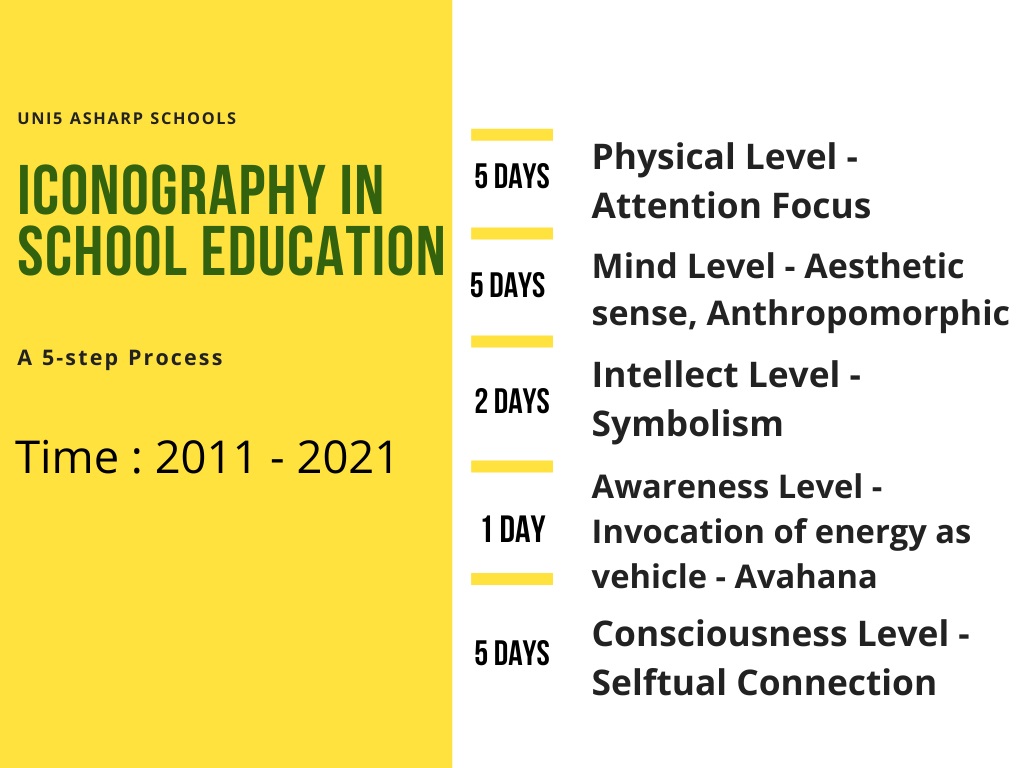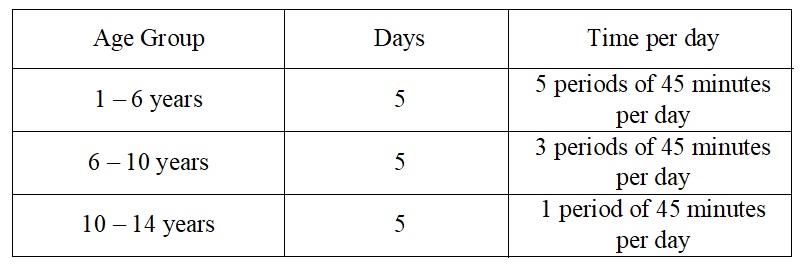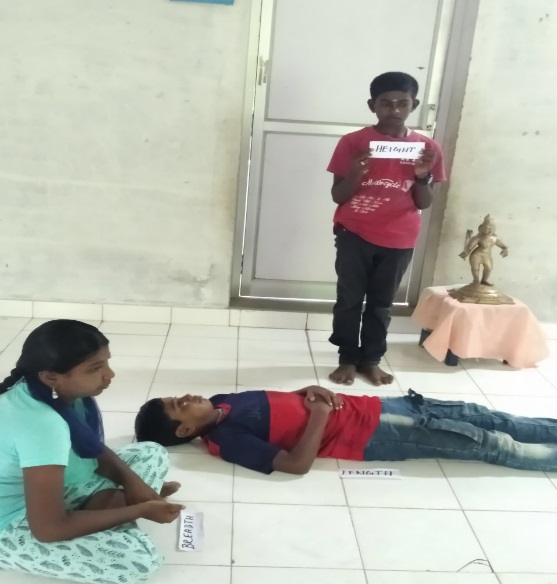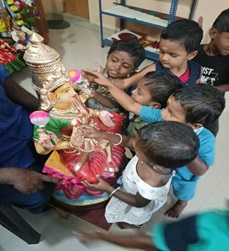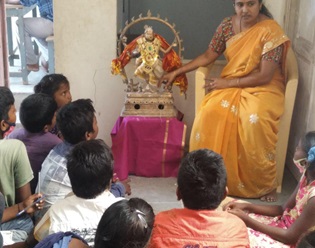Abstract:
Communication is an act of conveying information, feelings and ideas between two living beings, which in turn develops a strong relationship between them. Symbolic gestures or images (signs) along with the effect of colours and sounds are also being used in this process to effectively convey our thoughts to achieve a meaningful communication. Paintings being a two-dimensional form of communication slowly paved the way for 3-dimensional form of sculptures, which depict the nature’s five levels of energy existence.
Communication through sculptures laid the foundation for our rituals and facilitated the connection of the self’s own existence on deeper levels to the eternal cosmic energy (God). In the Indian culture, sculptures had reached the pinnacle for being used as a medium for invoking and connecting one’s own existence to the cosmic energy. Sculptures and rituals have become a part and parcel of human life such that in the Indian tradition, God can be easily related to and communicated with in any form of expression based on an individual’s emotional and intellectual capabilities and limitations. Thus, throughout the history of humanity’s growth and development, sculptures of Gods have been depicted as means to attain natural powers.
Even in the ancient Gurukul educational system, all aspects of humanity and nature were communicated through sculptures where sculptures were always used as means of communication to convey all the intellectual and emotional understandings between the teacher and the students.
Similarly, the Uni5 A-SHARP School System has revived this effective medium of teaching right from the primary level of education. This is because a newborn child is more like a clean slate, absorbing information from the external world through the five basic senses. Right from the sense of touch to the sense of smell, the sculptures can play a huge role in an efficient and deep learning process. They can help elevate the children to grasp the energy patterns of nature in order to develop a higher level of intelligence and a balanced emotional state of mind, which is necessary for leading a happy life.
All branches of Science, Arts and Languages are being taught through this method, which is traditionally known as Shilpa Shastra, and we also have excellent feedback from children, students, teachers and parents on this holistic approach of teaching.
Introduction:
Communication is an act of conveying information, feelings and ideas in order to develop a strong relationship between two different beings [1]. Symbolic gestures or images (signs) along with the effect of colours and sounds are also used to effectively convey information [2]. All five sensorial channels of communication can play a huge role in the evolution of organisms. Even cells in our body communicate with each other using chemical messengers and bioelectromagnetic signals in order to perform the bodily functions [3].
Primitive men who lived in the caves during the prehistoric era first started to express their ideas through visual communication, which formed the basis for arts in the form of symbolic images, alphabets, numbers etc. This further helped to communicate with fellow beings and also with nature or the subtle energy aspects (God) [4]. Overtime, the mode of communication has evolved into complicated and effective spoken and written languages [5].
Paintings being one of the two-dimensional forms of communication slowly gave rise to the three-dimensional sculpture form through which nature’s five levels of energy existence is being depicted [5][6]. Communication through sculptures has laid the foundation for the self to connect to the deeper levels of one’s own existence to the eternal cosmic energy through various rituals. Sculptures in our Indian tradition have reached the pinnacle for being used as one of the medium to invoke and connect oneself with the cosmic energy. This has caused a radical shift in the human understanding of the cosmic governing process and also paved the way for one of the most important philosophical ideologies, “As is the microcosm so is the macrocosm”.
Soon sculptures became a tangible form for one to connect, relate and share their existence to their higher self. In the Indian tradition, sculptures and ritualistic actions had become a part and parcel of everyone’s day-to-day life. God can be related to and communicated with through any form of expression that can overcome our emotional and intellectual limitations. Thus, throughout the history of humanity, Gods were depicted in the form of sculptures and also as one of the means to attain natural powers.
The remnants of such a cultural tradition had spread to all over the world and can even be seen in today’s modern society. For example, saluting our national flag, adorning the sculptures of our leaders with flowers is practiced, even by atheists today. They are considered to have descended from this cultural tradition. Likewise, firing guns or cannons is still practiced as a gesture of honour in military and none of us have considered it as an unnecessary superstitious act.
Atheism in the current society has slowly made Sirpa (Shilpa) Sastra to be conceived as a dummy and meaningless act. The cosmic energy can be invoked in the sculptures and can become an effective medium to communicate with the divine source. The neglect of this science of communication through idols in school education has created a chasm between people and temple idols.
Even the ancient Gurukula system of education has communicated all the aspects of humanity and nature through the form of sculptures. Sculptures were always used as an effective bridge to convey the intellectual and emotional understanding between a teacher and his/her students. Thus, ancient temples have always stood out as centres of learning.
In Bharath, every art is a medium of communication. The 64 different types of arts are the best medium through which man can convey the divine expressions of nature. One amongst them is Shilpa Sastra. The temples have always been at the centre for conveying the expressions of divine energy through idols, carvings, rituals and festivals help to get a better understanding of life through the help of the divine truth [7].
All this knowledge was conveyed in a pattern-based system in ancient India because the pioneers like Samkhya Kapila Acharya knew that knowledge can be cognized through both spatio-temporal and non-spatio-temporal pattern or the pancha-bhoota pattern. This spatio-temporal belonging to both the space and time was brilliantly conveyed through the guru-parampara system of education [3, 5, 7]. Here the teachers are conveying their knowledge in the form of five energy pattern-based system and the students who receive it through this pattern can apply it in their practical life. The hand with its five fingers is very effectively used as the medium of this learning process.
This traditional lineage is the basis of Uni5 educational system, which is indeed based on the system of universal energy pattern. In this revolutionary age of artificial intelligence (AI), there arises a question, ‘If lifeless machines can manage to learn and recognize patterns to be smart, then why can children not learn advanced patterns and become smarter?’
The Uni5 System of Education provided by SHARP or Schools Helping Advanced Recognition of Patterns can be divided into two models, the SHARP and A-SHARP schools.
A-SHARP is recognizing patterns through anthropomorphic forms, i.e., human-like forms (sculptures). Many ancient cultures used anthropomorphic style to teach the concepts of energy evolution. Through energy symbols (analogy), one can learn and understand the concepts very quickly, like learning the “zero to nine” Indian mathematical symbols. Like the 10 mathematical symbols, the energy pattern is also imparted in 2×5=10 format. A-SHARP uses human forms of energy symbols in the anthropomorphic model.
There is a common misunderstanding that anthropomorphic models depict the energy pattern as a symbol of religion. Therefore, in such cases, the Uni5 system in the SHARP model is used without the anthropomorphic model [8].
Uni5 school system continues to get excellent feedback from teachers, parents and general public about this pattern-based education in developing the children’s ability to grasp every concept along with good behavioural patterns. The efficiency of the Uni5 system is continuously being researched on children aged between 1 to 14 years, since 2007.
Since 2011 the Uni5 system of school has revived this effective medium of teaching through several educational and hand activity materials including sculptures with Shilpa Sastra, starting from the primary level of education. This is because the newborn child is more like a clean slate, ready to be filled with the information from the external world through the means of the five basic senses. Right from the feel of touch to the very sense of smell, the sculptures play an important role in the learning process. This helps the child to grasp energy patterns of nature and develop higher levels of intelligence and a balanced state of emotional mind, which is absolutely necessary to lead a happy life.
In this system of education, right from the time when a child is in the mother’s womb, he/she is introduced to the pattern-based universe and its functionality based on pancha-bhutas. The regular exercises given in the schools can make the children slowly realize and connect with the universe to better understand the concepts of life.
Since 2011, in these 10 years of research-based study, sculptures were introduced to students right from pre-primary up to 8th standard in a school at Porayer, Tamil Nadu. One of the authors, who was simultaneously working in another school which only had a Montessori and IGCSE system, introduced Shilpa Sastra in his school only in the language class in contrast to all subjects in Uni5 A-SHARP schools.
The objective of this research study is to understand the efficiency of using Shilpa Sastra in classrooms to learn all the subjects including Arts, Science, Math and Social Sciences. Every concept is viewed from the Uni5 five levels–Physical Body, Emotional Mind, Holistic Intelligence, Self-Awareness and Unity Consciousness. In Shilpa Sastra also, these five levels of Uni5 are introduced step by step based on the child’s age.
Figure 1: Number of days allocated for emphasis on different levels of iconography for children of different age groups in a school week.
Level 1 – The physical structure of the sculpture (Shilpa) and the effect on the child.
Any physical object in this world can easily draw a child’s attention to make him or her to focus on it, because every child perceives this world mainly through its five basic sensory organs. An infant, especially in the early growing stage of his or her lifespan, will be unstable and finds it difficult to focus on any particular activity for a long period of time, because a growing child’s immature brain constantly seeks a lot of new sensory information from its surrounding environment in order to better understand and adapt to the habitat where the child is living in.
Therefore, interacting with physical objects can play a huge role in creating focus and attention in a growing child. If not practiced at an early age, it may have a long-lasting impact on the child’s behaviour and his or her ability to learn, thus affecting his or her quality of life in the future. Parents mostly have a common complaint that unlike in the young age, their children are finding it difficult to focus on their studies overtime as they start growing older. But one thing that they fail to understand is that they study mostly due to the outcome of fear and pressure to be obedient to their parents and teachers, and not due to their own self-interest. Then, after a particular stage in life, children become desperate to attain everything that was denied to them in their childhood. This can create a lot of problems in the relationship between a parent and their child and creates an illusion that their child has become disobedient. This kind of misunderstanding between the parent and their children can get even worse when the child enters teenage or adolescence.
Not just behavioural problems, even genetic disorders like ADHD, autism, and other attention deficiency disorders in children can be easily rectified if the first level of Uni5 treatment is given at a very early stage of a child’s development. Sculptures can offer more to a child than toys and educational materials because more than just stimulating the sensory, emotional and intelligent levels of a being, sculptures can stimulate the inner levels of a being.
Level 2 – The emotional aesthetics of the sculptures (Shilpa) and their effect on children
Though physical objects like sculptures can be noticed visually, the duration of attention they can hold is highly influenced by the attractiveness or aesthetic qualities of colors, shapes, texture, smell and even taste of that the object.
Level 3 – The symbolic intelligence of the sculpture (Shilpa) and its effect on children
As energy tends to reach higher realms, the child’s ability to stay focused can further stimulate the ability to think (intelligence). Symbolic messages conveyed through the sculptures can further develop the thinking ability of a growing mind by helping the children to describe their thoughts in a poetic form or in any other art forms and also creates an ability to understand the scientific nature of the universe and its origin. This UNI5 program can further help the children to excel in their chosen field when they pursue higher studies and can provide them a successful professional career due to their enhanced ability to think.
Level 4 – The self-awareness energy of the sculpture (Shilpa) and the effect on children
This level is an applied branch that can help us to connect to the cosmic universal pattern through the means of sculptures by self-connecting to the attributes of the symbolic message it conveys. This helps oneself to evolve in order to achieve higher qualities in life and also helps an individual to lead a purposeful and happy life. However, considering the child’s age, this is conveyed as personality that can adhere to higher values and lead a happy and prosperous life.
Level 5 – The unity consciousness of sculpture (Shilpa) and its effect on the child
This level is an advanced applied level where the individual would be able to self-connect through the sculptures and becomes a complete, socially responsible person by serving for the welfare of all other beings. However, as a child, this is conveyed through love and compassion to help fellow beings as oneself or “SELFTUAL”.
A research analysis was conducted on the extent to which the five energy levels of concepts are being effectively grasped by children of different age groups.
Methodology:
This research was conducted in various UNI5 A-SHARP schools from 2011 to 2021 involving children from three different age groups of different categories ranging from 1-6 years, 6-10 years, and 10-14 years. They included both girls and boys from preschool [since 1 year] till middle school students [grade 8, 13 years] from different religious backgrounds.
In the classroom for teaching different subjects like language, science, math, and social science, several educational materials including sculptures were used. Also, in addition to that, every week we have a special 45-minutes session for decoding the symbolism of sculptures (Table 1).
Table 1: Use of Sculptures in learning concepts in different age groups of students in classrooms
Model Classroom Sessions Used In The Study:
These are a few examples
- Physics of light: The concept of light with seven VIBGYOR colours were effectively communicated using the sculpture of Sun God in a chariot pulled by seven different coloured horses. The horses are placed in descending order of size such that the Violet-coloured horse is the biggest followed by horses in decreasing sizes depicting indigo, blue, green, yellow, orange, and red. This enables the children to easily understand that ultraviolet (UV) light has more power to penetrate into a medium than infra-red (less intense). They can relate this with the speed of light in physics, which will always be constant, and that only the frequency and the energy are responsible for the colours. Here, we use the Sun God chariot driven by horses sculpture for the symbolic representation of our cognition where we see frequency and the energy in the form of colours. This 3-D form of sculpture experience imparts long-term learning in children. This unique feature makes Uni5 System an efficient learning methodology.
- Sculptures of three forms of Vishnu (the energy aspect of measurements and calculations) in standing, sitting and lying postures are used for easy learning of the concepts of length, width and height. The lying posture takes too much space and is compared to length. In sitting posture, the space occupied gets reduced and it is compared to breadth. In the standing position, the amount of space decreases a lot compared to the two previous postures and it is compared to height. Similarly, geometry is taught with the help of Yantras in our Uni5 Schools, which is in the form of puzzle pieces to comprehend the shapes of circles, squares and triangles.
Figure 2: Children in age group of 10-14 years are learning mathematics with sculptures and real time experience in all five levels of being.
- Similarly, languages, literature, history, geography, and civic sense are also conveyed through the anthropomorphic form of sculptures that enable children to learn quickly. The national spirit is conveyed through the icons of Bharat Mata and the flag she holds as a tool to convey the roles and responsibilities of the citizens.
Results:
The study introduced Uni5 system of teaching concepts using sculptures (Shilpa Sasthra) to different age groups and was evaluated at five levels of its efficiency (Figure 1).
- Physical Body Level – how well they were engaged in the classroom. Here the 6-10 age group showed more response (46%).
- Emotional Mind level – how well they enjoyed the aesthetics of the sculpture and the level of engagement with the concepts that was taught. Here the 6-10 age group/ showed more response (42%).
Figure 3: Children in age group of 1-6 years touching the sculptures and feeling them in all five levels of being.
Figure 4: Children in age group of 10-14 years curious to know about symbolism and connect them in all five levels of being.
- Intelligence level decoding Symbolism – how well they think and understand the art of communication through symbolic images and also the science behind it. Here the 6-10 age group showed more response (50%).
- Awareness level of self–connection to the sculpture – what qualities they like to imbibe from the sculpture symbols for their personality development. Here the 6-10 age groups and 10-14 age groups showed the same response (36%).
Consciousness Level of Selftual Love – how much they develop empathy for all beings. Here the 6-10 age group showed more response (43%).
Figure 5: Differences in understanding the concepts using sculptures by the three age groups in Body Level, Mind Level, Intellect Level, Awareness Level and Consciousness Level.
Discussion:
It is a universal challenge experienced by parents and teachers to make a child focus on the learning process. This is because it is natural for parents to expect the desired outcomes in children in all walks of life. However, a positive parent-children interaction along with a good teacher-student relationship is crucial for the healthy development of children from birth till the age of 8 [9]. These challenges are dealt with in a positive manner in the Uni5 system of teaching. Children taught under this system showed more interest in learning and are more attentive in class and do not disturb the functioning of any classroom session.
Children also developed higher focusing skills while performing any activity even at an early age, as shown in our research study (Figure 5). This has shown long-term benefits that can be observed in their higher education and professional life as well. The children are given enough space and time to express what they feel and also develop excellent communication skills.
In Uni5 A-SHARP school system, a healthy, stress-free environment is given for children to learn all concepts efficiently and effortlessly using various educational materials including sculptures. Sculptures are silent communicators and children learn the art of that communication when they are exposed to it. They also grow to relish and appreciate all art forms through the sculptures (Figure 3).
As the child grows, the curiosity to decode the symbolism expressed by the sculptures starts building up (Figure 2,4). There are several feedbacks from parents that their children now respect architecture and idols and also convey the knowledge behind them when they visit temples. They also appreciate and show attention to all kinds of arts. They understand the traditional values of our culture.
Children are now more focused and engaged in class because they realize that they are learning about their own self and they themselves are part of the learning system. Since there is no passive teaching with a book or blackboard, they visualize, touch and feel and hence connect to the concept that is being taught to them. Children are able to re-collect and connect concepts easily because every object and form is resonating with one of their own levels of being. So, they were able to sharpen their memory process effortlessly.
Children become smart and intelligent through patterns and can grasp language, arts, mathematics, science, and many other subjects very quickly and simultaneously. They can connect all the concepts to themselves by being creative. Generally human activities are divided into scientific and artistic creativity based on modern educational system [10]. In the Uni5 system, both the left and right hemispheres of the brain are being activated and hence a balance in the growth of personality is being achieved through emotional and intellectual development.
Highlight of the Uni5 education system is that the children can connect everyone to themselves and develop love and compassion towards everyone, the pinnacle of Human inner evolution.
Figure 6: Comparison of perception of different age groups about the five levels.
Conclusion:
This research study shows that in UNI5 A-SHARP Schools system of teaching, the use of 3-D forms of sculptures (Shilpa sastra) is very effective in facilitating the learning process. The children are engaged in learning and also interested in more conceptual learning, showing a matured behavioural pattern. Thus, we strongly recommend this system of using sculptures (Shilpa Sasthra) in all the classrooms.
Acknowledgments:
We thank all the teachers and staff of Porayar School and other Uni5 schools. We thank all our donors who contributed for this project.
References:
- Kumar, Sanjay, and Lata, Pushp: Communication Skills, Ist Edition, 2011 Oxford University Press.
- Grouchy P, D’Eleuterio GM, Christiansen MH, Lipson H. On The Evolutionary Origin of Symbolic Communication. Sci Rep. 2016;6:34615. Published 2016 Oct 10. doi:10.1038/srep34615
- Kučera, O., &Cifra, M. (2013). Cell-to-cell signaling through light: just a ghost of chance? Cell communication and signaling: CCS, 11, 87.https://doi.org/10.1186/1478-811X-11-87
- A-SHARP Uni5 Schools – learning made easy through the Principles and Concepts of Universal Selftual Energy Pattern 2022. Selftual Publications, India.
- Universal Selftual Energy Pattern 2022. Selftual Publications, India.
- Vinzenz Brinkmann; RaimundWünsche; Susanne Ebbinghaus; Amy Brauer; Arthur M. Sackler Museum (2007). Gods in color: painted sculpture of classical antiquity. Munich: Stiftung Archäologie: GlyptothekMünchen.
- Temples and Universal Selftual Energy Pattern 2022. Selftual Publications, India.
- https://uni5sharp.com/
- Parenting Matters: Supporting Parents of Children Ages 0-8. Washington (DC): National Academies Press (US); 2016 Nov 21. 2, Parenting Knowledge, Attitudes, and Practices. Available from: https://www.ncbi.nlm.nih.gov/books/NBK402020/
- Shi, B., Cao, X., Chen, Q., Zhuang, K., &Qiu, J. (2017). Different brain structures associated with artistic and scientific creativity: a voxel-based morphometry study. Scientific reports, 7, 42911. https://doi.org/10.1038/srep42911
Feature Image Credit: istockphoto.com
Watch video presentation of the above paper here:
Disclaimer: The opinions expressed in this article belong to the author. Indic Today is neither responsible nor liable for the accuracy, completeness, suitability, or validity of any information in the article.


